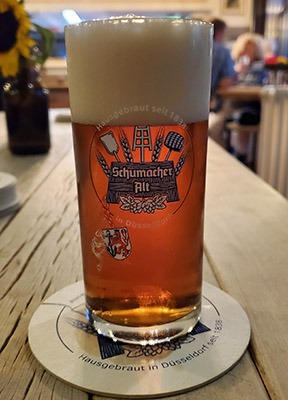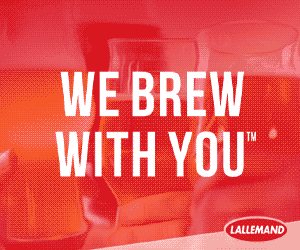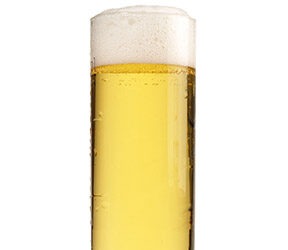Schumacher Latzenbier clone
(5 gallons/19 L, all-grain)
OG = 1.055 FG = 1.013
IBU = 42 SRM = 7 ABV = 5.5%
Ingredients
10.5 lbs. (4.8 kg) Pilsner malt
12.5 oz. (354 g) Weyermann CaraMunich® Type I malt
5.6 AAU Hallertau Tradition hops (60 min.) (0.86 oz./24 g at 6.5% alpha acids)
3.2 AAU Perle hops (60 min.) (0.43 oz./12 g at 7.5% alpha acids)
4.3 AAU Spalt hops (20 min.) (0.86 oz./24 g at 5% alpha acids)
1 tsp. Irish moss (15 min.)
White Labs WLP036 (Düsseldorf Alt), Wyeast 1007 (German Ale), or SafAle K-97 yeast
¾ cup corn sugar (if priming)
Step by Step
I currently use all Weyermann malts for my German beers. Feel free to substitute any high-quality malt of the same type and color from a different supplier. The Düsseldorf brewers often use whole hops, but pellets are seen more often these days. Just make sure that the hops you use are German-grown varieties.
The water profile in Düsseldorf favors chloride-to-sulfate at 1.26-to-1 and is moderately hard. If your water is soft, a bit of gypsum and calcium chloride will help.
This beer should be made using a decoction mash. First infuse the mash at 133 °F (56 °C). Your first decoction should be approximately 4 quarts (3.8 L) of mash, boiled and returned to the mash tun for a rest temperature of 153 °F (67 °C). The second decoction would be approximately 5.5 quarts (5.2 L) to reach mash out at 169 °F (76 °C). Keep the initial infusion rest short, just long enough to see that you hit your strike temperature, then pull the first decoction. Then rest 40 minutes on the saccharification rest. Sparge slowly with 170 °F (77 °C) water, collecting wort until the pre-boil kettle volume is around 6.75 gallons (25.5 L).
The total wort boil time is 90 minutes. Add the Hallertau and Perle hops with 60 minutes remaining in the boil and the Spalt with 20 minutes remaining. Add Irish moss or other kettle finings with 15 minutes left in the boil. Chill the wort to 68 °F (20 °C) and transfer to an open fermentation bucket or bin. Aerate thoroughly if using a liquid strain and then pitch the yeast.
The beer should warm with fermentation activity. If it appears to be fermenting too hot, above 73 °F (23 °C), you can move the fermentation to a cooler area. If fermentation seems sluggish at all after the first 24 hours, move fermentation to a warmer area. With healthy yeast, fermentation should be complete within a few days, but do not rush it.
If you wish to more closely mimic the real thing, you can rack the beer over to a keg with a spunding valve when it reaches 1.016 SG and let natural fermentation develop carbonation. Alternatively, ferment it out completely and then force carbonate or rack to a bottling bucket, add priming sugar, and bottle. Target a carbonation level of 2.8 volumes. After a month or more of cold conditioning at near-freezing temperatures the beer should be ready to enjoy.
Extract with grains option: Replace the Pilsner malt with 6 lbs. (2.7 kg) of Pilsen dried malt extract. Begin by placing the crushed CaraMunich® malt in a muslin bag and steep it in 4 gallons (15 L) of water as it heats up to 170 °F (77 °C). Remove grains, allowing the liquid to drip back into the kettle. Remove from heat and stir in the dried malt extract. Stir until completely dissolved. Bring wort up to a boil and add first hop addition. Boil for 60 minutes, adding the second hop addition with 20 minutes remaining.
After the boil is complete, chill to 68 °F (20 °C) and top up fermenter to 5.25 gallons (20 L) with water.
Follow the remainder of the all-grain recipe for fermentation and packaging instructions.
Written by Jamil Zainasheff

Latzenbier, at 5.5% ABV, is a bit more malty than Schumacher’s everyday altbier, yet still nicely balanced toward the bitter end.



